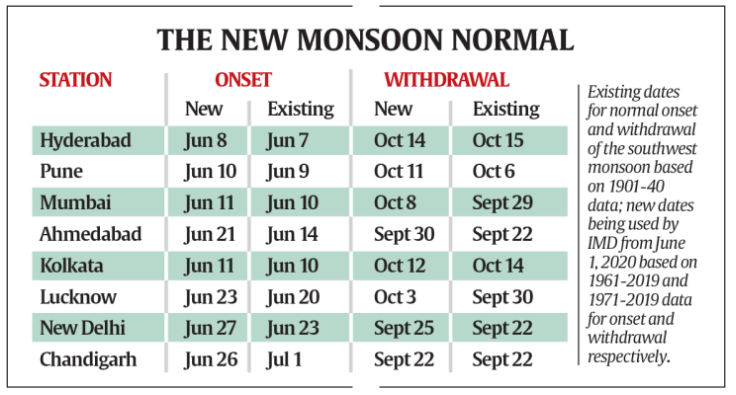ForumIAS announcing GS Foundation Program for UPSC CSE 2025-26 from 27th May. Click Here for more information.
Contents
Source: The post is based on the article “The lingering monsoon” published in the Indian Express on 12th October 2022.
Syllabus: GS -1 – Important Geophysical phenomena
Relevance: About the shift in the Indian monsoon
News: Incessant rain over Delhi and several other parts of North and Northwest India over the last few days provide further evidence of the shifting patterns in monsoon activity over the Indian subcontinent.
What is the shift in the Indian monsoon?

The monsoon season earlier confined neatly to the four-month June-September period. But it is clearly spilling over into October now. The monsoon rainfall has also become more erratic — fewer rainy days but more intense rain. Extreme rainfall events are increasing both in intensity and frequency. For instance, Delhi had its fourth-wettest October of the last 120 years.
The recent spell of rainfall over Western Uttar Pradesh, Uttarakhand, Haryana, Eastern Rajasthan and Delhi were a result of the interaction of monsoon winds, moving east to west, with the western disturbance wind system. Such interactions happen several times during the monsoon season.
Due to this, three years ago, the India Meteorological Department (IMD) had revised the expected dates of onset and withdrawal of the monsoon for several regions of the country. The withdrawal dates for North, Northwest and Central India were pushed back by one to two weeks to account for the trends witnessed over the last 50 years.
What is the reason for the shift in the Indian monsoon?
Climate change: The shift in the Indian monsoon is being driven primarily by climate change.
Global warming: One possible reason for the spillover of monsoon rainfall to October could be the fact that the oceans (Bay of Bengal and Arabian Sea) are now warmer than earlier.
Warmer ocean currents help the formation of monsoon winds. Earlier, rainfall during the monsoon season would bring down the temperature of the ocean. But possibly because of global warming, the oceans continue to remain warm even after the traditional monsoon season is over.
Similarly, a warmer atmosphere has a greater capacity to hold water. When this water is finally released, it often results in a heavier downpour.
What are the challenges associated with the shift in the Indian monsoon?
A challenge for forecasting: The IMD has over the past 10-12 years, invested heavily in setting up observational equipment, upgrading computing resources, and fine-tuning weather forecast models. But despite that, the IMD is battling public perception for its generic forecasts.
Impact on Indian economy: A significant part of Indian agriculture still depends on monsoon rainfall for irrigation. The supply of drinking water and the generation of electricity are also linked to the monsoon.
Dam management: Most reservoirs in the northern and central parts of the country seek to attain full capacity levels by the end of September because not much rain is expected after that.
What needs to be done to adapt to the shift in the Indian monsoon?
Augment IMD capacity: Capacity upgradation has to be a continuous exercise. So, India need to set up more observation stations, collect more data, and do more computing.
Follow-up action in agriculture and economy: Not just the preferred time of sowing of crops, but the entire cropping cycle — even the choice of crops — might need to be changed.




